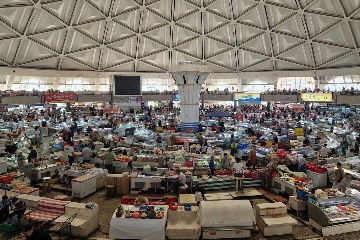Beneath the colossal turquoise dome—a celestial shield against the Central Asian sun—Chorsu Bazaar thrums like a living organism, its stone arteries pulsing with the sweat of farmers, the laughter of spice hagglers, and the metallic clang of butchers sharpening blades still glistening with morning slaughter. Step inside, and the air itself becomes a tapestry: cumin's earthy bite swirls with bergamot oranges piled like stolen sunlight, while beneath your feet, crushed coriander seeds crackle like distant gunfire under boots worn smooth by generations of melon-hauling grandfathers.

To the left, mountains of paprika rise in crimson pyramids taller than a horseman's head, their slopes patrolled by women in ikat robes bartering for saffron threads measured in grams of gold dust. To the right, a cavern of hanging carcasses—sheep ribs splayed like ivory harps, their marrow still warm—where cleavers dance to the rhythm of haggling tongues. Venture deeper, and time fractures: a toothless crone sells Neolithic-looking cheese wheels beside a TikTok-ing teen stacking Korean skincare serums, both framed by towers of walnuts that have rolled down these same cobblestones since Tamerlane’s cooks seasoned lamb for his armies.
In the dome's shadowed western arcade, the true alchemy unfolds. Here, white-bearded masters finger prayer beads while weighing emerald-hued raisins once trampled by Silk Road camels. Their calloused hands, mapped with veins like dried riverbeds, wrap kurpacha cushions stitched with anti-evil eye patterns in newspaper scraps bearing yesterday's soccer scores. Nearby, a hammer dulcimer crafter taps out rhythms on mulberry wood—the same notes that lulled Babur to sleep in this valley before he conquered Delhi.
Follow the honey trail to where golden combs drip onto slabs of halva studded with pistachios, their sweetness clashing gloriously with the acrid tang of fermented mare's milk sold in goat-skin pouches. Watch a melon vendor's knife—a curved shamsir relic—slice through amber-fleshed gourds with a whisper, juice pooling around Soviet-era weight stones stamped with hammer-and-sickles.
As noon's heat intensifies, climb the dome's perimeter stairs. From this vantage, the bazaar becomes a living mosaic: bursts of crimson pomegranate seeds against saffron dunes, the cobalt swirl of a potter's glaze mirroring Uzbekistan's flag, and endless human currents flowing where caravans once carried jade to Ming emperors. Below, a wizened hat-seller demonstrates his chapan's silk strength by suspending his grandson from the sleeve—tradition and survival woven into every thread.
This is no market. It's a carnival of survival, a theater where the ghosts of Sogdian traders nod approval as Bitcoin brokers haggle over AI-designed ceramics. The dome doesn't shelter wares—it incubates stories, each stall a verse in Central Asia's unbroken epic of hunger, craft, and the sacred chaos of human exchange.




































